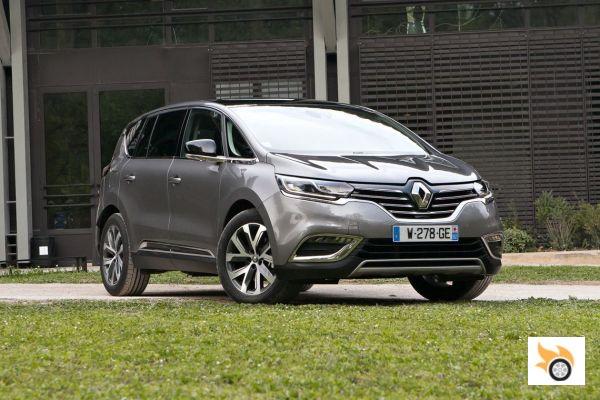
In 1984, when the first generation of the Renault Espace appeared (although it was originally a Matra project), the car was a revolution. To venture into the path of such an avant-garde architecture had its risks, but the success was such that it conquered the world and the whole industry followed in Renault's footsteps, both generalists and specialists. The Espace really invented the MPV segment.
Stop. Before you lapidate me for forgetting the Dodge Caravan/Chrysler Voyager (released in November 1983), I must say that I'm not forgetting that minivan. Although Matra's management came up with the idea for the Espace by looking at American vans, the 1983 Voyager was nothing more than a van, i.e. a minibus reduced to a passenger car format. Even in terms of design it was never really a minivan, as the bonnet was always very pronounced in its silhouette, unlike the Espace where the windscreen was an extension of the bonnet.
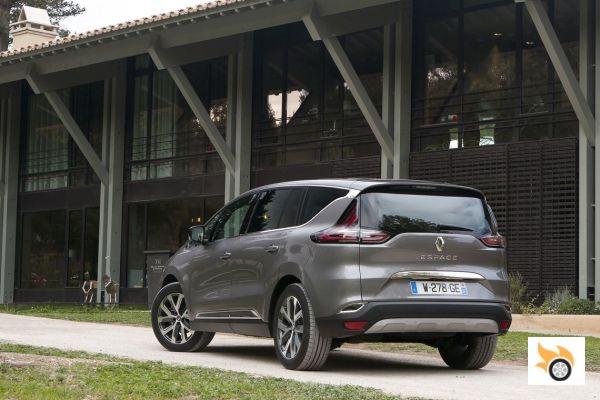
But above all Renault added to Matra's proposal an innovation that put the Espace under the spotlight of the industry. The Espace had a truly modular cabin that made it a welcoming space. For example, during a break in the road, the front seats swivelled backwards and the central rear seat could be transformed into a table. What for? To decide the fate of one of your shipyards with your partners. Or to play a game of mus. The why was a bit irrelevant, given the efforts required to reorganise the Espace's cabin. How many users actually made use of these possibilities? How many users gave up using the immense interior volume of their car because they had nowhere to put the heavy seats (22 to 14 kg each, depending on the generation), which were mounted on rails once removed? A lot, according to Renault itself. Add to that the fact that the MPV segment in Europe has been in freefall for several years now, and you have the answer to why it took Renault so long to revamp the Espace.
Design
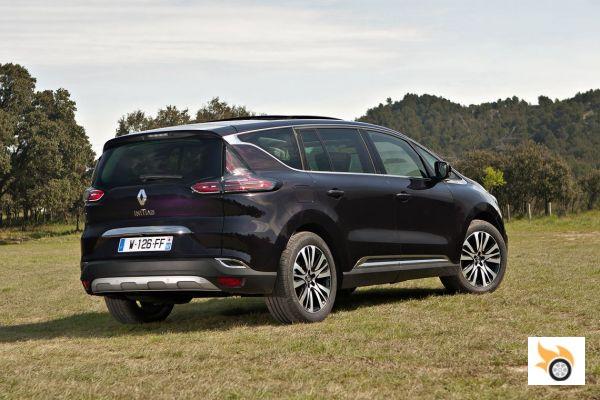
Let's make it clear right off the bat: the Renault Espace as we knew it is dead. The fifth generation of the Espace, unveiled on the Espace's 30th birthday, almost completely disavows the legacy of the previous four generations and aims to reinvent itself. This radical change of direction is instantly apparent in the car's design. The Espace says goodbye to the MPV body and joins the crossover trend, following in the footsteps of the Captur and Kadjar.
The silhouette becomes more muscular and the front end gains strength.
The silhouette becomes more muscular, especially at the rear around the tail lights, while the bonnet of the car is now shaped. The front end gains a strong presence with full LED headlights and a grille presided over, as always, by a huge diamond. The wheels now have an imposing diameter, 18 inches as standard, and the ground clearance is now 16 cm (previously 14 cm). It's enough to remind us of a 4×4 without really being one, as it doesn't have four-wheel drive. The result is an imposing and somewhat statuesque image. Something that can also be seen in its dimensions: 4.85 m long (the same as a Grand Espace 4) by 1.89 m wide and 1.68 m high. In the end, François Lemoine (author of the exterior design under the supervision of Laurens Van Den Acker) has achieved a car with a fairly dynamic silhouette despite the car's dimensions.
Interior
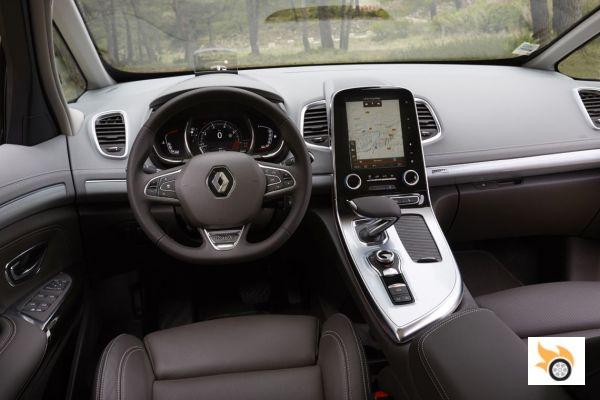
It is on board the Espace that the changes are even more striking. Renault's engineers and designers have come up with a cabin that is radically different from the previous generation. Right off the bat, the eye goes to that floating centre console and its 8.9-inch touchscreen (one of the largest, if not the largest in a mainstream model) which houses the new R-Link 2 infotainment system. The system erases the drawbacks of the previous one: it's like a tablet. It's intuitive to use and the information it provides can seem enormous at times. From there you control, for example, the climate control, music, navigation, the chosen driving mode (the Multisense we talked about below) and even which seats you want to fold down. By the way, the R-Link 2's hardware and software are by LG, while the navigation is handled by TomTom.
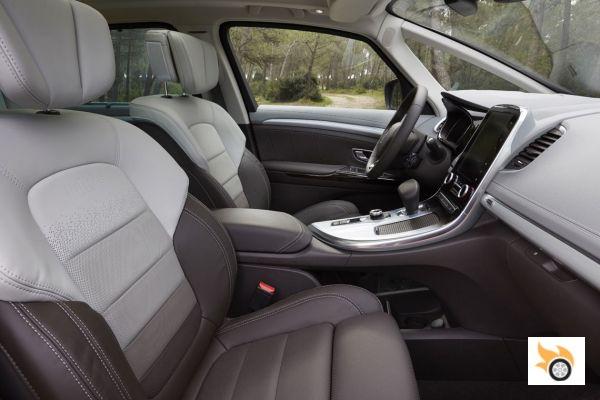
On board, the modularity is lost, the habitability is preserved and a futuristic dashboard is gained.
The driver has in front of him a 100% digital instrumentation, although in its graphics looks analog, and for the first time in Espace a head-up display. This is a small methacrylate screen on which all kinds of information can be projected: speed, traffic signs that indicate the speed on the stretch -by reading the signal and not by GPS position-, safety distance with the car in front and/or navigation.
The co-driver, meanwhile, has numerous storage compartments available: under the center console, in the doors and a huge glove box type drawer, which as you are very close to it when you open it will give you in the legs. The lower part of the dashboard and doors is where the hard plastics are most noticeable. It's a shame because the finishes have progressed a lot and even have a certain premium touch in the upper areas. In most of the finishes you will notice a little less, but in the luxurious top of the range Initiale Paris, they sing a little.
At the rear, the changes compared to the previous Espace are even more evident. The wheelbase has grown little compared to the previous generation (+ 2 cm) and remains stable at 2.88 m. Even so, passengers in the second row of seats have 4 cm more legroom at knee height: 308 mm of legroom. The second-row seats are still individual and mounted on rails for each of the three passengers to move forward or backward as they wish (12 cm of travel), but the seatbacks are not reclining. However, while the third row of seats (optional, from 743 euros to 991 euros, depending on the finish) retains the individual seats are now a simple emergency or child seats. These seats are hidden under the boot and once opened, legroom is very limited - it also forces you to move the second row seats as far forward as possible, otherwise there is no legroom - and access is very uncomfortable. It's a system similar to that of a compact MPV.
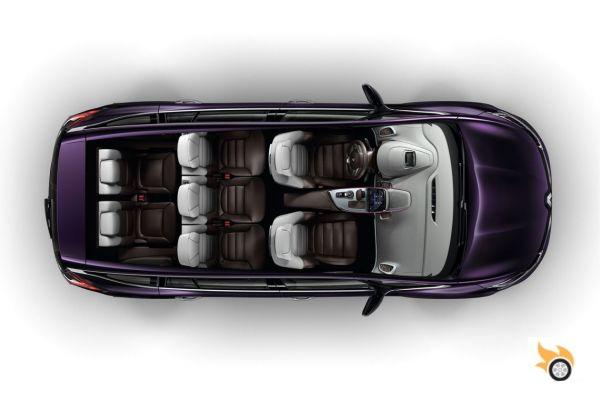
It's true that the Espace is no longer an interesting proposition for large families. In any case, Renault must have thought that given the birth rate in Europe, it's not such an important market, especially if these families have the purchasing power to afford an Espace. In the end, the majority of users win an Espace with a significant ease of use, especially in terms of the boot.
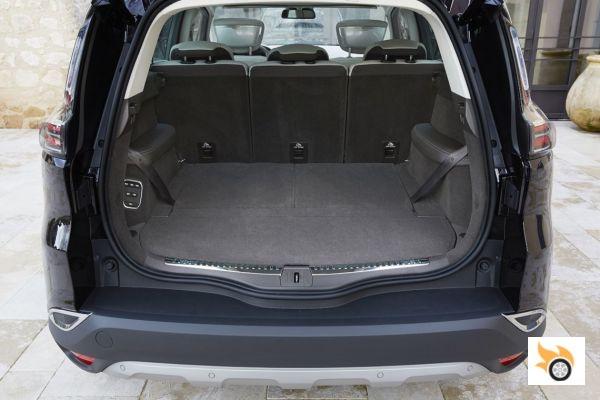
It loses in height, but gains a lot in modularity. You no longer need to remove the heavy seats (and find a place to store them without them getting dirty) if you want a larger boot. Simply press one of the buttons on a console to the left of the boot, or via R-Link from the driver's seat, to fold down the backrest of the seat(s) you want individually or all at once. This way, the load space is completely flat. But to put the seats back in place, you'll have to do it the old-fashioned way: with your bare hands. In any case, the boot volume remains consistent: from 260 litres to 2,035 litres, depending on the configuration. In 5-seater configuration, the volume is 680 litres. While these are honourable volume values, in the 7-seater version it's not so much. The car measures as much as a 7-seater Grand Espace, but offers only 260 litres in that configuration when the Grand Espace offered 455 litres.
Engines
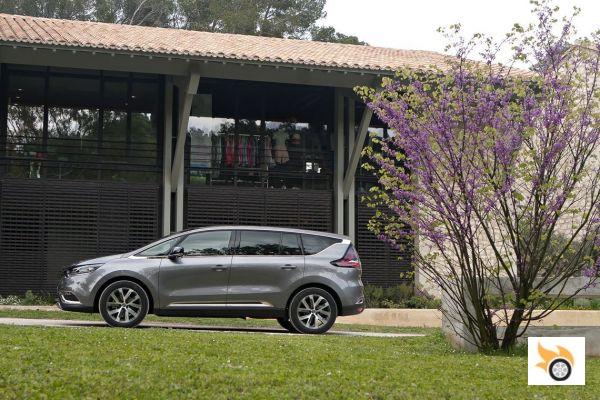
Renault offers three engines for the new Espace, two diesel and one petrol. In diesel the range starts with the dCi 130 (1.6 litres; 130 hp; 320 Nm and 4.4 l/100 km on average) associated with a 6-speed manual gearbox. It is worth noting that in this case the centre console loses the storage space underneath. The second diesel is the dCi 160. With a displacement of 1.6 litres, this twin-turbo engine produces 160 bhp and delivers 380 Nm for an average fuel consumption of 4.6 l/100 km. It is coupled with a 6-speed automatic transmission. Lastly, Renault offers the TCE200 petrol engine, the 1.6-litre turbo from the Clio RS (200 bhp; 260 Nm and 6.2 l/100 km) combined with a 7-speed automatic transmission.
In this contact were only available only the dCi 160 with Intense finish (the highest below the Initiale Paris) and TCe 200 with Initiale Paris finish. It should be noted that in Spain, the Initiale Paris will only be available with the dCi 160 engine.
Behind the wheel
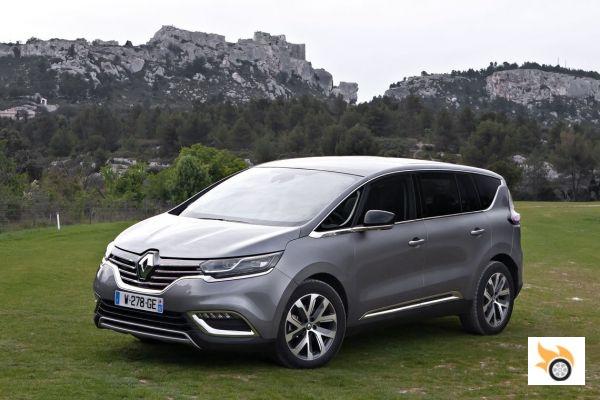
In general, a vehicle of this size and type is not exactly agile on the road, with one exception: the Ford S-Max. Now the Ford is no longer alone, as the Renault Espace has pleasantly surprised me in this respect. Gone is the slow and heavy shifting of the old Espace, whose handling was a bit clumsy, not to say worthy of a commercial vehicle. Obviously, the new Espace retains a somewhat high centre of gravity, which has unsuspected consequences (such as tipping over in one of the EuroNCAP tests, although it gets 5 stars) and in its behaviour. Renault manages to erase the effect of the high centre of gravity thanks to a number of technologies.
The new Espace is 250 kg lighter than its predecessor, yet the Espace 5 weighs 1,609 kg in its lightest version, thanks to the use of hot-drawn steel (lighter and just as strong), the use of aluminium for the bonnet and doors, Noryl (front wings) and thermoformed plastic (tailgate). But above all, the use of 4Control four-wheel steering inherited from the Laguna and the adaptive suspensions used on the multi-sense mean that one can have a bit of fun behind the wheel of the new Espace.
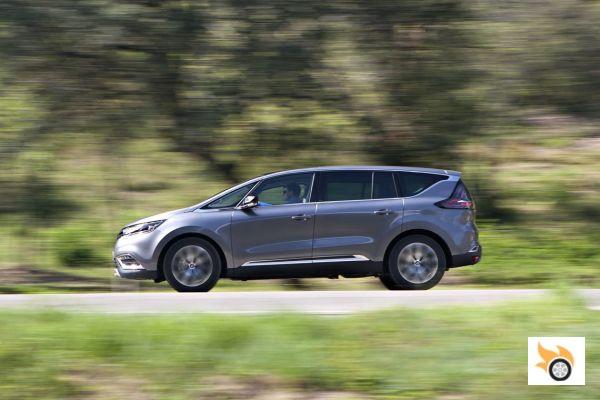
Renault's multi-sense is the possibility of adopting up to 5 settings of the mechanical part according to our mood: Eco, Comfort, Neutral, Sport and a customizable mode. The system influences the engine's response to the accelerator, the automatic gearbox's gearshift, the steering assistance and the damping of the piloted suspension, all associated with a variation of the interior lighting and instruments (sepia in Neutral, Red in Sport, etc.).
Eco mode is to save fuel, but it's terribly boring and slow. Comfort and Neutral mode (this is the default mode) offer excellent comfort in exchange for noticeable body roll. The Espace is unabashedly tumbley in corners and doesn't encourage you to attack. Even so, the suspension is still a little firm on rough surfaces, which causes a little bounce. In Comfort mode, the steering assistance is blatantly excessive.
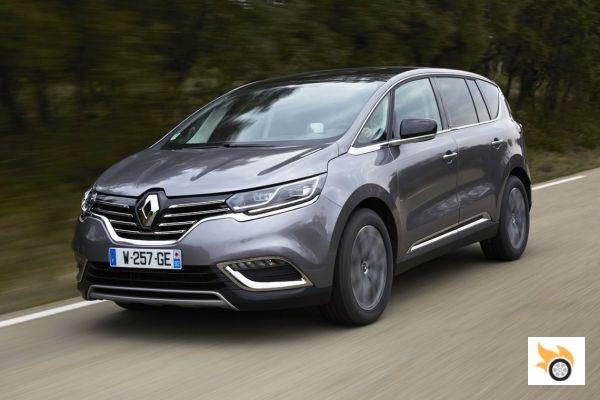
Without reaching the level of a Ford S-Max, the Espace is agile on the road.
In the end, I liked the Sport setting better. (That's to be expected). The steering assistance is what I consider ideal: neither too hard nor too soft. Whatever the mode, it doesn't transmit anything at all. The suspensions offer an excellent control of the body movements that together with the 4Control transform this heavy and huge car into a very agile vehicle. The Espace 5 goes into corners without a hint of sluggishness and with a straightforward steering response. Obviously, it retains a slight touch of understeer, reassuring for most drivers, which makes the trajectory tend to lengthen a little more. I found the Espace's lane departure warning system to be very effective: it simulates acoustically that you're stepping over rough white lines. In other words, it's the most natural way of warning us (no beeps, little lights or Citroën-style vibration massages on the seat). Dynamically, it's not as alert or direct as the Ford S-Max, but it behaves much better than most MPVs on the market. Still, we'd have to test an Espace dCi 130 with "analogue" suspension.
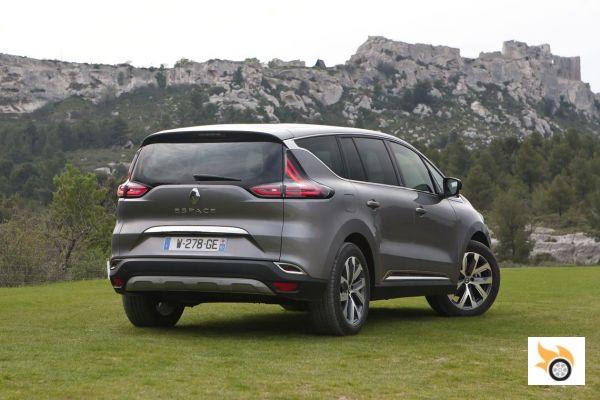
In Nîmes, I was able to test both the dCi 160 and the TCe200, both with automatic transmission. The diesel, thanks to the 380 Nm available from 1,750 rpm, is very willing. In Sport mode, the engine revved happily and the accelerations were frank. It's true that in this mode the gearbox holds the gears until after 4,000 rpm, but it's more to put you in a situation than out of necessity, shifting at 3,000-3,500 rpm the result is the same. It must also be said that in the Espace, the EDC is a bit slow but its operation is very smooth. Anyway, you can always shift yourself by pushing the electric shift knob. However, I recommend that you practice without traffic beforehand. Because the knob is electric (there is no mechanical connection to the gearbox), it has no feel. Consequence: on one occasion I downshifted 3 gears at once instead of one and on another I was in neutral overtaking on an uphill slope and with a truck approaching in the distance... My co-driver did not flinch, I spent a few seconds of anguish. The moral of the story? Let the gearbox work, don't touch it and keep your foot on the accelerator with a kick-down.
The TCe200 is even more acoustically refined than the diesel (in both cases, the Espace is a quiet car), and despite its higher maximum torque, it's also a more nervous engine and offers slightly better performance (0-60mph in 8.6s for the TCe 200 and 9.6s for the dCi 160).

























